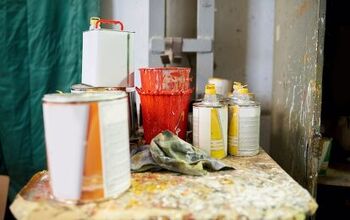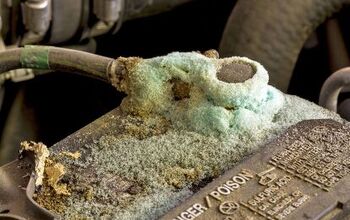How To Dispose Of Mineral Spirits (Step-by-Step Guide)

For the most part, mineral spirits make certain household tasks easier. Thinning out oil-based paints, cleaning out paintbrushes, and even degreasing metal tools and parts is a simpler process because of mineral spirits.
Getting rid of those spirits that have been used is not as easy. The liquid portion, which is also known as white spirits, is considered to be a hazardous waste and requires proper disposal. If you don’t have a local disposal center, contact your local waste pickup to see if they have designated removal dates.
Disposing of Mineral Spirits
Step 1: Find Your Nearest Hazardous Waste Center
Before you can hope to remove those mineral spirits from your home, you first need to locate the closest hazardous waste center. Depending on where you live, there may not be one terribly close and you’ll have to make a little bit of a trek to properly dispose of your mineral spirits.
It is also worth noting that, if your area doesn’t have a year-round facility, your town, city, or county may have special pickups specifically for hazardous waste. Just make sure to label your container “mineral spirits” so that your recycler knows what is inside of the container. This will allow them to dispose of it properly.
Step 2: Storing Them for Transport
If you do have a hazardous waste collection center, you will need to prepare the mineral spirits for safe transportation. You can store those mineral spirits in a well-constructed box or plastic bag for safe transportation.
Don’t keep them in the cabin of the car with you. Put your mineral spirits container in the back of the truck or in your trunk to ensure safe transportation. Plastic bins that are sealed can also be fine for disposal purposes, just check with your removal center first to be safe.
Step 3: Dropping Them Off
Now that your mineral spirits have been safely contained and are ready for transport, it’s time to drop them off at the hazardous waste collection site. Follow the instructions at the site or ask the person there what needs to be done. For the most part, they will handle the complicated part for you.
In situations where your town or city has a specialized pickup day, put the spirits into a bottle or plastic container first. Then, put that container into a noncombustible container a short time before the designated pickup time.
Putting your mineral spirits out just before pickup time is important. Doing this is meant to prevent the liquids inside from either burning or exploding in the event of a spark. Mineral spirits might have a really high burning point (473 degrees Fahrenheit), but its flashpoint – when the fumes can potentially ignite – is just 104 degrees. In warmer areas, that leads to a potential risk for fire or explosion if left out for a while.
Can You Dump Mineral Spirits Down the Drain?
It is imperative that you never, ever pour mineral spirits into the sewers or down your drains. Mineral spirits are toxic and can potentially contaminate the groundwater. They are so potentially toxic that they should not even be poured into a garbage can or onto the ground.
Mineral spirits should only be disposed of through the designated pickups or at your local waste management plant. Contaminating the groundwater can lead to potential health impacts not only for you but for others in your area.
Do Mineral Spirits Evaporate?
In some cases, certain solvents of higher volatility can evaporate pretty easily. One option for disposing of liquid mineral spirits is to set the container outside and let it evaporate into the atmosphere.
These mineral spirits, in small quantities, should pose no threat to the air quality when allowed to evaporate. The general rule of thumb is that the more surface area there is, the quicker the mineral spirit will evaporate. So, using a large, shallow pan would work better for evaporation purposes than something that is narrow and tall.
Can Mineral Spirits Spontaneously Combust?
As mentioned previously, one of the major concerns with leaving mineral spirits out on the curb is that they can potentially overheat and catch on fire or explode. Ignition is definitely possible whenever the conditions are met and there is a source for the ignition.
Mineral spirits will not, however, self-heat. Certain mineral spirits that have linseed oil in them can potentially spontaneously combust. Handling these responsibly and safely is of the utmost importance to prevent fire or explosion.
Will Mineral Spirits Melt Plastic?
Storing mineral spirits in plastic containers, whether it is for later use or for transportation, is oftentimes recommended. But it is important to keep in mind that there are some types of mineral spirits that can actually dissolve certain plastics.
Paint thinner is one type of mineral spirit that will eat away at HDPE, EPDM, and ABS plastic. Likewise, linseed oil will eat away at EPDM, neoprene, and rubber. Ethyl alcohol, which is actually okay for you to drink, can dissolve polyurethane. Any other kind of spirits should store safely in a plastic bin for later use or transportation to a disposal center.
Can You Touch Mineral Spirits?
We know some of the uses for mineral spirits, as well as some of the hazards when storing it for removal or disposal. Since mineral spirits are made from a number of different chemicals, they can potentially be hazardous for your health if they are mishandled.
When it comes to your skin, mineral spirits can cause skin burn or an irritating rash. And if a larger amount of spirits come into contain with the skin – or it isn’t washed away in the proper amount of time – it can lead to a serious skin burn that causes scarring.
Can Mineral Spirits Lead to Poisoning?
Mineral spirits can contain dangerous chemicals within. So, it only makes sense that if they are swallowed or inhaled, mineral spirits poisoning can occur. Hydrocarbons are the poisonous ingredients within the mineral spirits. These are the ingredients that contain only carbon and hydrogen (think methane and benzene).
You would generally find these poisonous ingredients in your standard solvents, some furniture and floor polishes and waxes, dry cleaning fluids, paints, and white spirits. Keep in mind that this is not a universal rule; some mineral spirits won’t contain these poisonous ingredients.
The symptoms of mineral spirits poisoning are widespread. You may have difficulty breathing or swelling of the throat. Severe pain or burning in the eyes, nose, lips, tongue, or ears is also possible. Vision loss is a severe symptom.
If ingested, you may not symptoms like blood in your stool, severe abdominal pain, vomiting, and burning of the food pipe. In the event of ingestion, it is highly recommended that you go to the hospital for treatment before symptoms worsen.
What are the Uses of Mineral Spirits as a Cleansing Agent?
Mineral spirits have a ton of different uses, but they are particularly good when acting as a cleansing agent. They can be a powerful degreaser used for cleaning machinery or automobile parts. They work by eating away at the chemical and oil grease, washing the part clean of those tough substances.
Mineral spirits can be used to erase dripping or mistakes made during the painting process. They are also quite useful when attempting to clean metallic tools and objects of grime and dirt. Mineral spirits are particularly good at combating dried on paint that can accumulate and become thick.
The mineral spirits dissolve and break down the paint, making it easier to rinse away. Even better, mineral spirits won’t compromise the quality and look of the object in question whereas using a scraper can potentially damage the surface beneath.
With a small amount of mineral spirits, you can also polish and clean wooden furniture. It is particularly effective for wooden furniture that has been coated with varnish, shellac, or lacquer without compromising or breaking down that protective layer.
Will Paint Thinner Melt Plastic?
Certain types of mineral spirits like paint thinners, have the potential to attach certain types of soft plastics and can even slowly dissolve certain things like Styrofoam. For the most part, though, paint thinner will play nicely with plastics.
Lacquer thinner is where you need to be extra careful. It will not only dissolve soft plastics and chew away at Styrofoam, but it will also eat away at certain types of acrylics as well. Use proper caution when using lacquer thinner.
What Can I Use Instead of Mineral Spirits?
Mineral spirits may not be available in the area that you live. There are some out there that also do not like to deal with the toxic properties that some mineral spirits possess. So, what can you use an alternative to mineral spirits?
There are plenty of options available depending on what the intended use may be. You can try using turpentine, acetone, denatured alcohol, and even charcoal lighter fluid, among other things. Whatever alternative that you choose to use, it is imperative that you refer to manufacturer instructions.
Each of these products contain certain ingredients that may be flammable or potentially dangerous to inhale, so all protective measures should be taken.

Ryan Womeldorf has more than a decade of experience writing. He loves to blog about construction, plumbing, and other home topics. Ryan also loves hockey and a lifelong Buffalo sports fan.
More by Ryan Womeldorf



























